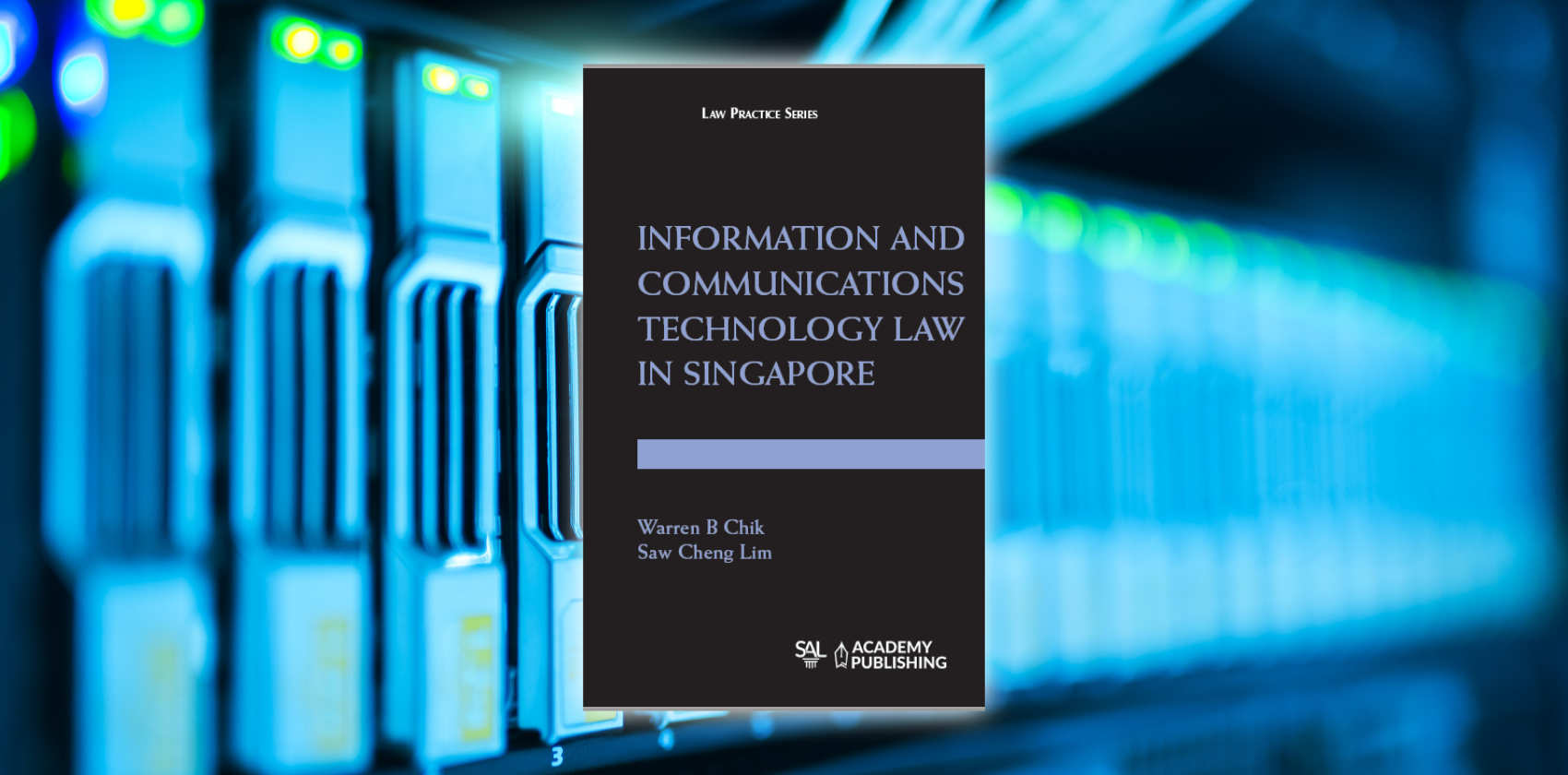Information and Communications Technology Law in Singapore
by Warren Chik, Saw Cheng Lim
This 480-page inaugural edition is a very thorough and meticulous analysis into the evolving subject of Information and Communications Technology (ICT) Law. The law in this inaugural edition is stated to be as at May 2020.
The book begins by defining ICT law as well as technology. It usefully separates information technology from communications technology, and against this background, the historical evolution of ICT is explained, traversing data collection and analytics in different static and interactive web environments (Web 1.0 v Web 2.0).
In terms of internet content regulation, the authors have been thorough in tracing the road to media convergence, the historical stewardship by the relevant agencies, and also the internet regulatory “class licensing framework” under the Broadcasting Act. The book usefully sets out the obligations and approach towards governance that apply to the internet content provider and internet service provider, being two protagonists of significance on the internet stage, as prescribed by the Internet Code of Practice. In terms of topical awareness (as at the time of publication), a significant 40 pages are devoted to recent laws against deliberate falsehoods, under Singapore’s new regime that includes the Protection from Online Falsehoods and Manipulation Act (POFMA) and Protection from Harassment Act. This is a timely and welcomed contribution. There is a useful section where the authors study the global trends in anti-fake news law, by reference to the treatment of falsehoods in several South East Asian countries (Malaysia, Philippines and Thailand), as well as Europe and the US.
The steady and important rise of electronic commerce has been given due recognition through the authors’ treatment of the updating of the Electronic Transactions Act since its inception in 1998. The currency of the work is exemplified by the discussion of the most recent decision by the Singapore International Commercial Court of Appeal in Quoine Pte Ltd v B2C2 Ltd [2020] SGCA (I) 2, on the subject of contractual vitiation, concluding with the salutary observation: “… the use of AI to conclude contracts should be done cautiously and with human oversight to avoid unintended transactions that may be upheld due to the lack of any lawful excuse, such as on the basis of the doctrine of mistake to vitiate agreements.”(at [03.078])
The work is noteworthy for its treatment of the law on internet intermediaries (including network service providers), in recognition that these intermediaries form the new vessels of liability in the evolving ICT landscape. The authors should be complimented for detailed treatment of this topic in areas of POFMA, electronic transactions, copyright liability, internet content regulation, personal data protection and spam control.
The chapter on computer crimes (Chapter 4) would equip readers with up to date precedents of prosecutions under the Computer Misuse Act, as well punishment and remedies, which practitioners would find particularly helpful. A similar approach is taken in the chapter on the Personal Data Protection Act (PDPA) (Chapter 5), where readers will be acquainted with detailed references to decisions of the Personal Data Protection Commission. Data protection lawyers would also welcome the comparisons and contrasts that are made with the European Union General Data Protection Regulation (GDPR), given that a working knowledge of the GDPR is taken as a given in the data practitioner’s arsenal.
The work should be commended for updating the subject of commercial messaging (Chapter 6) and the legality of new tools that are deployed in internet advertising, such as meta-tagging, keyword advertising, the use of hyperlinks (Chapters 8 and 9). With commercial messaging, the authors invest substantive discussion of Singapore’s Do-Not-Call (DNC) regime, making the call for the DNC regime to be eventually extended to specified messages that are addressed to internet protocol addresses and personal online accounts. This will ensure greater coverage, and cover telephony and other communications that are not solely based on a Singapore telephone number.
Readers will also be treated to a scholarly multi-jurisdiction discourse on the law relating to meta tags and keyword advertising (Chapter 8). The preference is expressed for the view expressed by the Singapore Court of Appeal in City Chain Stores (S) Pte Ltd v Louis Vuitton Malletier [2010] 1 SLR 382 that the concept of “use” in a trade mark infringement action should be only confined to a “trade mark use” (that is, the use of a sign by the defendant as a badge of origin). This converges with the CJEU’s analysis in Google France SARL v Louis Vuitton Malletier SA C-236/08, EU:C:2010:159 at [84] that a trade mark’s indicator of origin function is deemed to be affected by a defendant’s bidding on selected keywords, if the defendant’s advertisement does not enable normally informed and reasonably attentive users, or enables them to ascertain, with difficulty, whether the goods or services advertised originates from the proprietor of the trade mark or an undertaking economically connected to it, or originate from a third party. This fact-based inquiry sets the stage for future judicial treatment of advertising keywords. (at [08.048]-[08.049])
In the chapter on “Copyright and New Technology”(Chapter 10) the authors consolidate the views expressed in earlier published research on the exclusive (copyright) rights of reproduction and communication to the public, particularly with reference to online streaming and time-shifting services. A detailed discussion of the leading Court of Appeal decision of RecordTV Pte Ltd v MediaCorp TV Singapore Pte Ltd [2011] 1 SLR 830 invariably follows. The work also provides an insightful discussion on the copyright culpability that attaches to peer-to-peer file sharing networks. The chapter concludes with an introduction into Singapore’s latest judicial site-blocking regime.
In terms of the interface between intellectual property and ICT, the book does not disappoint, with useful discussions on hyperlinking, and entire chapters devoted to domain name disputes (Chapter 7) and also jurisdictional issues in online intellectual property disputes (Chapter 11).
At the outset, the authors are mindful of the increasing prevalence of discussions apropos the “tech of law”(as opposed to the law of tech) and mindful of the role that tech plays in the future of the legal industry. The tech of law falls outside the auspices of this book. However, the authors also recognise that the areas of artificial intelligence (AI) and ethics lie beyond the scope of the inaugural edition, but the authors also point out that the unique legal issues that arise from the development and exploitation of AI will be addressed in subsequent editions, as an inevitability. (at [01.016]
An admitted challenge to writing an authoritative text in this field is traversing an evolving and dynamic legislative landscape, particularly in the context of Singapore. At the time of publication, further legislative changes are already expected for the Personal Data Protection Act. The authors fully recognise this at [01.011] and should be congratulated for contributing a good standard-setting ICT text that will hold sway against future developments in the years ahead.
Launched as part of the Singapore Academy Publishing’s Law Practice Series, the authors should be congratulated for having managed to pursue a clarity in their approach towards selected ICT topics that would be didactic for the cognoscenti, whilst at the same time remaining accessible and informative to the tyro. The broad church of ICT practitioners, academics and students will find this book to be a tremendous resource in the effervescent ICT field.







